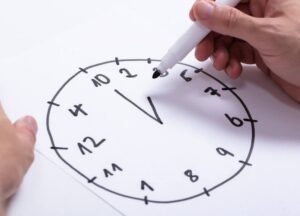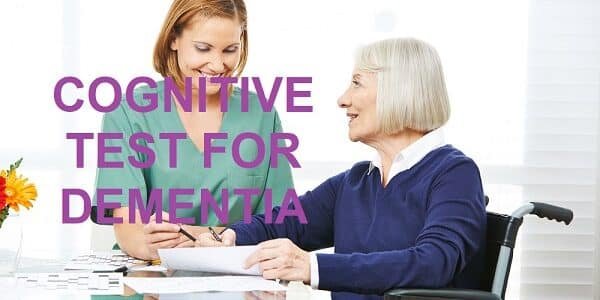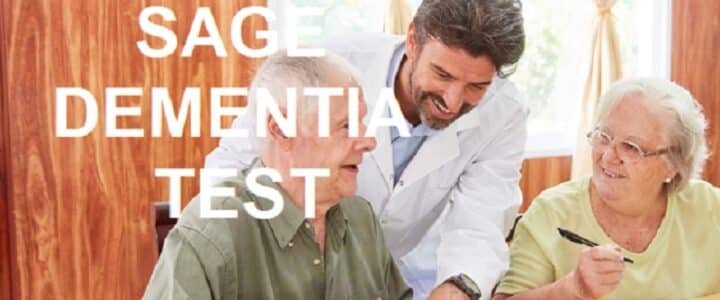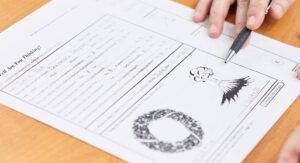The intention of this article is to assist our readers with selecting a cognitive test for dementia.
Alzheimer’s Disease and dementia is a complex illness that can have many different symptoms and causes. As a preliminary test of a person’s cognitive abilities a cognitive test can be used. There are various cognitive tests that practitioners use.
The common tests include:
- Mini-Mental State Examination (MMSE). Assesses cognitive function in areas such as memory, attention, and language.
- Montreal Cognitive Assessment (MoCA). Designed to identify mild cognitive impairment and early-onset dementia.
- Clock Drawing Test (CDT). Assesses a person’s ability to recognize and replicate a visual stimulus. The simple test gives insight into cognitive abilities such as spatial awareness and executive function.
- Self-Administered Gerocognitive Exam (SAGE). Detects early signs of cognitive, memory, and thinking impairments.
We discuss each of these tests in greater depth further into this article.
Note: the tests we have listed are preliminary tests. No single cognitive test for dementia can conclusively diagnose dementia. To have a correct diagnosis and develop a treatment plan, a thorough evaluation by a qualified medical professional is necessary.

The Importance of Early Diagnosis Using a Cognitive Test For Dementia
Dementia and Alzheimer’s Disease are progressive brain disorders affecting memory, concentration, behavior, and emotion. Dementia is the main cause of disability and dependency amongst the elderly.
Early detection of dementia is necessary for the following reasons:
Accurate diagnosis
For the best and most suitable treatment and care it is important to have an early diagnosis.
Access to treatment
There are treatments, therapies and medications that help with managing and treating some forms of dementia. With early detection, treatments can be accessed quickly. By doing so, quality of life can be improved, and the progression of the disease may be reduced.
Better planning
When dementia is diagnosed early, plans can be made ahead. Affected people are able to make necessary lifestyle changes, and put legal and financial affairs in order while the person with early dementia is still able to participate in decision-making.
Improved support
Early diagnosis allows for early support services for the person with dementia and their family. Appropriate support services would include counseling, education, and caregiver training.
Research
To help with efforts to better understand dementia, develop new treatments, and improve care for people with Alzheimer’s Disease and Dementia, it is beneficial when the disease is detected early with individuals.
Overall, early detection of dementia is important for improving outcomes for people with this illness. It benefits loved ones caring for a dementia patient, as well as for advancing understanding of this complex condition and how to better approach it with treatment.
4 Common Cognitive Tests for Dementia
1. Mini-Mental State Examination (MMSE)
The Mini-Mental State Examination is a cognitive test for dementia designed to assess cognitive function in adults. A series of questions are asked and participants complete tasks that evaluate various cognitive domains (orientation, attention, memory, language, and visuospatial skills).
The test takes 10-15 minutes and is scored out of 30. Higher scores indicate better cognitive function.
The test has been used widely. It is considered to be a reliable and valid measure of cognitive function.
It is not a complete diagnostic tool for dementia and therefore should be used in conjunction with other diagnostic measures conducted by a medical professional.
A limitation of the MMSE is the potential cultural and educational biases. This may affect the accuracy of the test for people who speak a foreign language or have a different cultural background.
2. Montreal Cognitive Assessment (MoCA)
The Montreal Cognitive Assessment was developed as an alternative screening tool to the Mini-Mental State Examination (MMSE).
It tests the following cognitive domains: attention, memory, language, visuospatial skills, and executive function.
This cognitive test for dementia consists of 30 items. A score of 26 or higher out of 30 is considered normal. Allow 10-15 minutes to give the test.
The MoCA is more sensitive than the MMSE in detecting mild cognitive impairment and early-stage dementia. It is becoming increasingly popular as a preliminary test.
This test has been translated into multiple languages and has been proven in a variety of populations. Therefore, it a useful test for assessing dementia in varied populations.
Once again, the MoCA should be used in conjunction with other diagnostic measures and not be used on its own to diagnose dementia.
3. Clock Drawing Test (CDT)

The Clock Drawing Test is a very popular, simple cognitive test for dementia. It is designed to detect early signs of dementia.
It tests visuospatial and executive function by requiring the person to draw a clock face from memory and set the time to a specific hour.
The clock test evaluates different aspects of the drawing. These include; the placement and size of the numbers, hands, and clock face.
Scoring the test is based on factors such as placement, size, and symmetry. The CDT can be a stand-alone test or used in combination with other cognitive tests. It is a sensitive and specific measure of cognitive impairment.
There are some limitations, such as the possibility of cultural and educational biases. Although it can be used as a stand-alone test, it is best used in conjunction with other tests.
Clock drawing Cognitive Test PDF.
4. Self-Administered Gerocognitive Exam (SAGE)
The Self-Administered Gerocognitive Exam is a quick to administer screening tool. The test assesses various cognitive domains that include orientation, language, memory, visuospatial abilities, executive function, and social cognition.
The SAGE takes 15-20 minutes to complete and consists of 12 questions.
This cognitive test for dementia is designed to be easily administered and scored by people with no formal training in cognitive testing.
It has proven to be a reliable and valid measure of cognitive function.
The SAGE can be self-administered. This allows people to conduct the test in the comfort of their own home.
Individuals can download and print a PDF of the test for administering.
The test should not be used as a sole basis for a dementia diagnosis.
| Self-Administered Gerocognitive Exam (SAGE) | Clock Drawing Test (CDT) | Self-Administered Gerocognitive Exam (SAGE) | |
|---|---|---|---|
| Cognitive screening tool | Cognitive screening tool | Cognitive screening tool | Brief, self-administered cognitive screening tool |
| Used to assess cognitive function in adults | Developed as an alternative to the Mini-Mental State Examination (MMSE) | Assesses visuospatial and executive function | Assesses various cognitive domains: orientation, language, memory, visuospatial abilities, executive function, and social cognition |
| Consists of a series of questions and tasks | Assesses various cognitive domains: attention, memory, language, visuospatial skills, and executive function | Requires the individual to draw a clock face from memory and set the time to a specific hour | Consists of 12 questions |
| Evaluates various cognitive domains: orientation, attention, memory, language, and visuospatial skills | Consists of 30 items | Used to detect early signs of cognitive impairment and dementia | Takes approximately 15-20 minutes to complete |
| Takes approximately 10-15 minutes to administer | Takes approximately 10-15 minutes to administer | Evaluates various aspects of clock drawing, including placement and size of numbers, hands, and clock face | Designed to be easily administered and scored by individuals with no formal training in cognitive testing |
| Scored out of 30 points | A score of 26 or higher out of 30 is considered normal | Scores are based on a variety of factors, including placement, size, and symmetry | Reliable and valid measure of cognitive function in older adults |
| Higher scores indicate better cognitive function | More sensitive than the MMSE in detecting mild cognitive impairment and early-stage dementia | Can be used alone or in combination with other cognitive tests | Useful tool for identifying early signs of cognitive impairment and dementia |
| Reliable and valid measure of cognitive function | Validated in a variety of populations | Has been shown to be a sensitive and specific measure of cognitive impairment in dementia | Self-administered, allowing individuals to assess their own cognitive function in the comfort of their own home |
| Used extensively in clinical and research settings | Translated into multiple languages | Has some limitations, such as the possibility of cultural and educational biases | To be used in conjunction with other diagnostic measures |
| To be used in conjunction with other diagnostic measures | Useful for assessing cognitive function in diverse populations | To be used in conjunction with other diagnostic measures | Not to be used as a sole basis for a dementia diagnosis |
| Not a definitive diagnostic tool for dementia | To be used in conjunction with other diagnostic measures | ||
| Potential cultural and educational biases should be considered | Not to be used as a sole basis for a dementia diagnosis |
How a Cognitive Test for Dementia Works
A person’s cognitive function are assessed using these screening tools. The tests identify mental processes such as attention, memory, language, and visual-spatial ability.
Cognitive strengths and weaknesses are identified as well as impairment or decline. The results help in the diagnosis of dementia and Alzheimer’s Disease.
5 Cognitive Domains Assessed by These Tests:
5 Cognitive Domains Assessed by These Tests:
- Orientation: Assesses a person’s awareness of time, place, and the ability to recognize and recall details about their surroundings.
- Attention: Tests focus and the ability to maintain attention on certain tasks, and the ability to switch attention between different tasks.
- Memory: Tests short-term and long-term memory. Assessing the ability to encode, store, and retrieve information.
- Language: Can the patient communicate effectively? This test assesses the ability to understand and use language, both verbally and in writing, to express themselves, and comprehending spoken and written language.
- Visual-spatial ability: Can the patient perceive and manipulate visual information? The test assesses the ability to recognize and interpret shapes, sizes, and spatial relationships.
Cognitive tests evaluate the domains through a range of tasks. Examples include: recalling a list of words, naming objects or pictures, drawing a clock face, or following complex instructions.
The person’s performance on these tasks, provides insights into their cognitive abilities and identify areas of impairment or decline.
Interpreting Cognitive Test For Dementia Results

To interpret results the practitioner requires a good understanding of the type of test being used. Also, the patient’s medical history, current symptoms, and other diagnostic information would be required.
Health professionals, such as psychiatrists, neurologists, and neuropsychologists, are usually responsible for interpreting cognitive test results.
When interpreting results, doctors consider a range of factors. These include:
Test scores
The raw score on each test provide important information about a person’s cognitive abilities. This helps identify areas of strength and weakness.
Age and education level
It is important to take into consideration age and education level. This can have a large sway on cognitive function.
Medical history
Knowing an individual’s medical history provide important context for interpreting test results. Any previous diagnoses or treatment for cognitive impairment or dementia should be noted.
Symptoms
Current symptoms and level of functioning may also provide important understandings into the severity and nature of their cognitive impairment.
Other diagnostic information
Medical practitioners will interpret test results in conjunction with other diagnostic information. This information may include imaging studies or laboratory tests. By doing so a more thorough understanding of the person’s cognitive function is established.
Scoring Systems for Various Cognitive Tests
Each test has a different method of scoring.
Mini-Mental State Examination (MMSE)
The test assesses orientation, attention, memory, language, and visual-spatial ability.
The test presents a series of questions. Each question is given a score based on the individual’s response.
The maximum possible score on the MMSE is 30. A score of 24 or lower indicating possible cognitive impairment.
Montreal Cognitive Assessment (MoCA)
This test assesses similar cognitive domains to the MMSE, but includes more complex tasks and measures.
The test gives a series of questions. Each is assigned a score based on the individual’s response.
The maximum possible score on the MoCA is 30. A score of 26 or lower indicates that there is possible cognitive impairment.
Clock Drawing Test (CDT)
This cognitive test for dementia assesses visual-spatial ability and executive function. The person being tested is given specific instructions requiring him/her to draw a clock face. The drawing is given a score based on accuracy and completeness.
The test is scored on a 6-point scale, with lower scores showing greater impairment.
Self-Administered Gerocognitive Exam (SAGE)
The SAGE assesses orientation, language, memory, visuospatial abilities, executive function, and social cognition.
The test gives a series of questions. Each question is given a score based on responses.
The maximum possible score on the SAGE is 22. A score of 14 or lower indicates that there is possible cognitive impairment.
Cognitive tests are scored based on the person’s performance on specific tasks or questions. Lower scores indicate greater impairment.
To provide a full understanding of a person’s cognitive function. Cognitive test for dementia scores should be taken in the context of the individual’s age, education level, medical history, and other diagnostic information.
Diagnoses and Treatment Plans

Cognitive test results are used to help diagnose and develop treatment plans for early dementia. Here are some ways that test results are used:
Diagnosis
A Dementia Neurologist will diagnose early dementia by looking at the results of a cognitive test for dementia.
Tests such as the Mini-Mental State Examination (MMSE), Montreal Cognitive Assessment (MoCA), and Self-Administered Gerocognitive Exam (SAGE) are all used to assess cognitive function and identify potential areas of impairment.
Severity Assessment
Results of these tests can help Doctors assess the severity of early dementia.
Scores on tests such as the MMSE, MoCA, and SAGE can be used to measure the degree of cognitive impairment and by repeating the test, track changes in cognitive function over time.
From this information, the development of treatment plans that are suited to specific needs of the person can be developed.
Treatment planning
Individualized treatment plans for people with early dementia can be developed using results from tests.
Such plans may include medication to manage symptoms, cognitive rehabilitation therapy to improve cognitive function, and lifestyle modifications to promote overall health and well-being.
The specifics of the treatment plan will depend on the collation of information from test results, medical history, and other diagnostic information.
Monitoring
Healthcare professionals can monitor the progression of early dementia over time by analysing test results.
By regularly testing, Doctors can track changes in cognitive function and, if required, adjust treatment plans.
A comprehensive assessment of cognitive function assist Doctors develop individualized treatment plans that address the unique needs of each person with early dementia.
Limitations of a Cognitive Test for Dementia

A cognitive test for dementia can be useful in assessing cognitive function and identifying potential areas of impairment, however, there are limitations to their use in diagnosing dementia. Here are some to consider:
Cultural and linguistic biases
Cultural and linguistic biases with some of the tests can impact test performance. For example, tests that rely heavily on language may be more difficult for individuals who speak a different language or who come from a different cultural background.
Education Level
People with low education levels may present less accurate test results. Some questions may be more difficult for those with less formal education.
Learning Effect
With repeated testing, individuals may improve their performance on cognitive tests. This can make it difficult to accurately assess changes in cognitive function over time.
Comorbid Conditions
Some medical conditions, such as depression or anxiety, can impact test performance. Such conditions may need to be considered in the diagnostic process.
Lack of Sensitivity
Some tests may not be sensitive enough to detect early stages of dementia or subtle changes in cognitive function.
Cognitive Test for Dementia – Final Thoughts
Cognitive tests play a vital role in detecting early signs of dementia. Detecting dementia early is important for effective management and treatment of the condition.
People who feel they, or someone they know, may be experiencing cognitive decline should seek professional medical advice as soon as possible. Start by talking to a primary care physician or a specialist in dementia.
Early diagnosis and treatment can help slow the progression of dementia and improve quality of life for both the individual and their caregivers.
Lifestyle considerations such as regular physical exercise, a balanced diet, and mental stimulation will contribute to promote better brain health and potentially reduce the risk of dementia.




